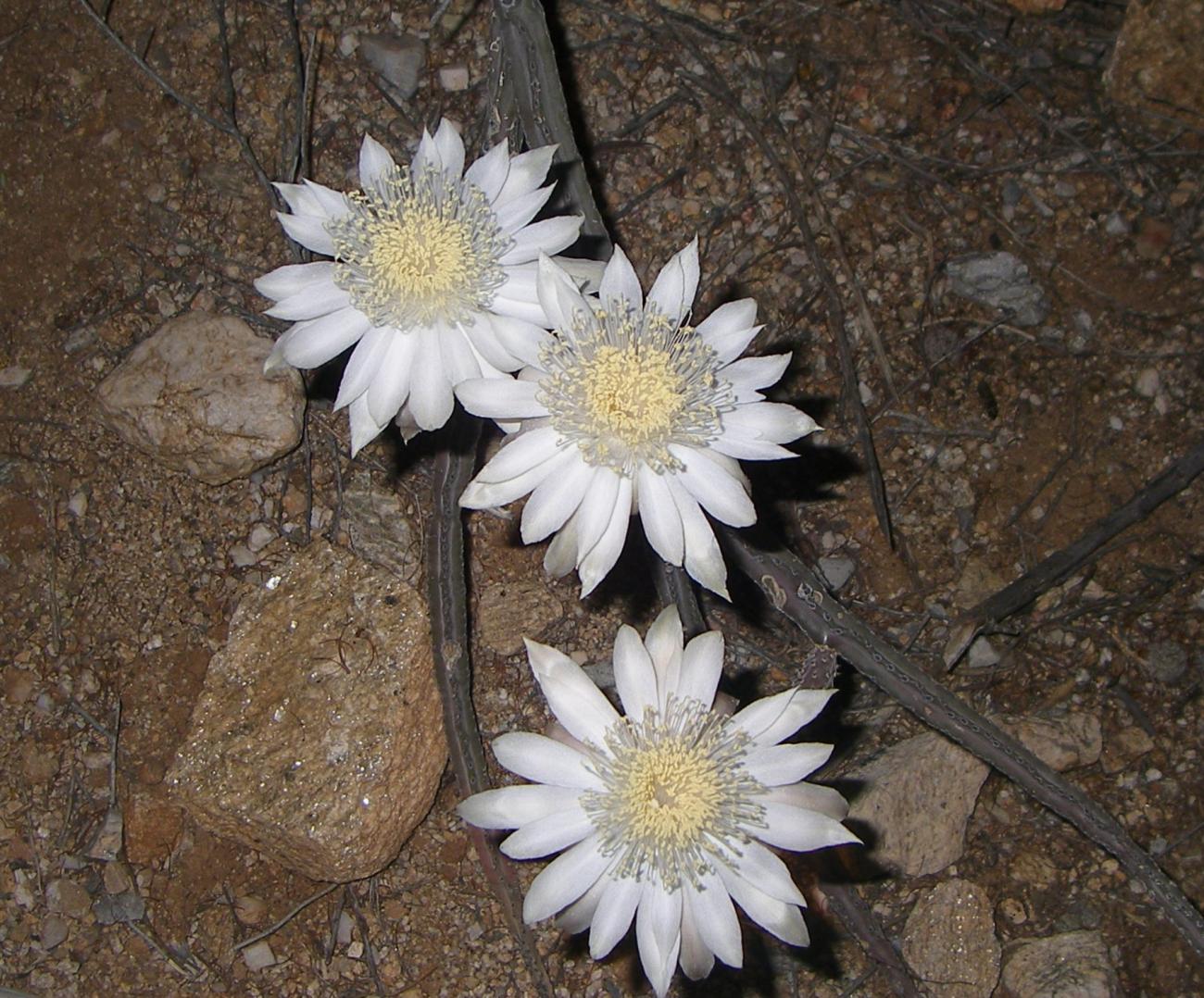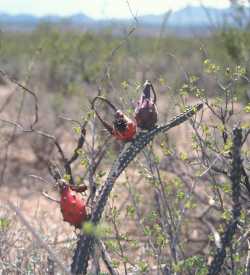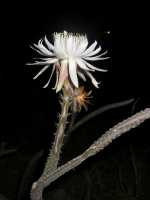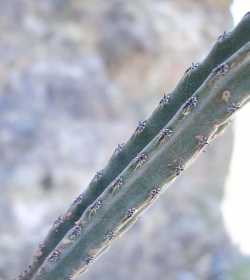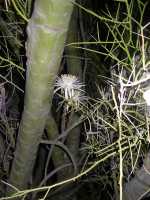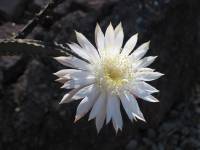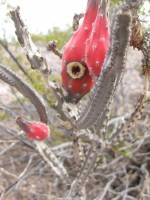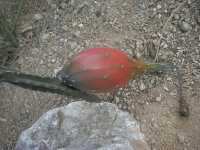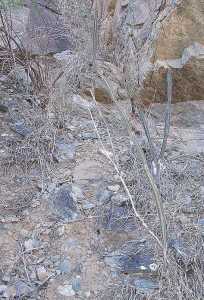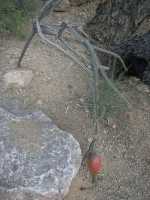Peniocereus greggii
|
|
|
|
Family: Cactaceae
Night-Blooming-Cereus, more...nightblooming cereus, Arizona queen of the night, desert night-blooming cereus, night-blooming cereus, Night Blooming Cereus (es: sarramatraca, huevos de venado, jaramatraca)
[Peniocereus greggii subsp. greggii] |
Shrubs, erect to sprawling, usually inconspicuous. Roots turnip-shaped, usually 15-30 × 5-12 cm (much larger ones known). Stems gray-green to gray, simple or with 2-5 branches, 40-120(-300) cm, distally 8-20 mm diam., at midlength ca. 10 mm diam., often narrowed toward base; wood hollow, solid-surfaced cylinders, 4-7 mm diam.; ribs 4-6, prominent; areoles (3.5-)12(-15) mm apart along ribs, circular to elliptic, 2-5 × 2 mm. Spines (9-)11-15(-17) per areole, usually in 3 vertical rows; abaxial 3-5 spines appressed, yellowish white throughout or only at tips, to 3 mm, puberulent when young; adaxial spines black, subulate, to 1 mm. Flowers: nocturnal (remaining open next day), 15-25 cm; scales of flower tubes green, tipped red or brown; outer tepals greenish white with brown to reddish midstripes; inner tepals white or lightly tinged cream or pink (or rarely all rose-pink), lanceolate-attenuate, apiculate, 4-7 cm, attenuate to mucronate; stamens 2.5 cm; anthers cream-yellow, 2 mm; style white, 10-14 cm; stigma lobes 9-11, white. Fruits bright red, darkening in age, ellipsoid, 60-90 × 40-50 mm. Seeds 3-4 × 2-2.5 mm. 2n = 22. Plant: Shrubs erect to sprawling, sparingly branched, inconspicuous, 0.4-1.2(-3) m tall; root solitary, large, light-brown, napiform, usually 15-30 cm long, 5--12 cm wide, but much larger ones are known . STEM gray-green to gray to purple, the distal parts 8-25 mm in diameter, bearing 4-6 prominent, angular, papillose-canescent ribs, the basal parts usually narrowed, brown and cylindric. AREOLES white-woolly, aging gray to blackish, (3.5-)4.5-12(-15) mm apart on each rib Leaves: SPINES black to yellowish-white, (9-)11-15(-17) per areole, usually in 3 vertical rows; apical ones black, subulate to 1 mm long; basal 3-5 spines yellowish white throughout to only at tips, thinner, to 3 mm long, appressed, puberulent when young Flowers: 15-25 cm long, 5-12 cm wide; floral tube papillose-canescent, the scales green tipped red or brown; tepals 4-7 cm long, lanceolate, attenuate to mucronate, the outer ones greenish white with brown to reddish midstripes, the inner ones white or lightly tinged cream or pink or rarely all pale rose pink; stamen filaments white, the anthers very pale cream-yellow Fruit: FRUITS bright red darkening in age, spiny, ellipsoid, snouted, 3-10.5 cm long, 2-5 cm in diameter; pulp red, fleshy, edible. SEEDS black, tessellate, wrinkled at hilum region, ca. 3-4 mm long, 2-2.5 mm wide REFERENCES: Pinkava, Donald J. 1995. Cactaceae. J. Ariz. - Nev. Acad. Sci. 29(1): 2, 6 Benson 1969, FNA 2006 Common Name: nightblooming cereus Duration: Perennial Protected Status: No status in Arizona, but endangered in New Mexico. General: Slender and erect to sprawling but usually inconspicuous, the roots are deep, large and turnip shaped, the stems are gray green to gray and simple or with 2-5 branches that are each 40-120 cm tall, it is narrowed toward base and has 4-6 prominent ribs. Spines: Areoles are 12 mm apart along ribs and circular to elliptic, each 2-5 mm by 2 mm with 11-15 spines per areole, usually in 3 vertical rows, the abaxial 3-5 spines are appressed and yellowish white throughout or only at tips and are 3 mm and puberulent when young, the adaxial spines are black, subulate and only reach 1 mm. Flowers: Nocturnal and 15-25 cm in diameter, the scales of flower tubes are green and tipped red or brown, the outer tepals are greenish white with brown to reddish midstripes, while the inner tepals are white or lightly tinged cream, they are 4-7 cm and attenuate to mucronate with stamens about 2.5 cm long and anthers that are cream yellow, with a white style, 10-14 cm. Fruits: Bright red, darkening in age, it is ellipsoid and 60-90 mm by 40-50 mm. Ecology: Found under trees and among branches of bushes and trees in sandy or gravelly loams, on edges of washes and on slopes of small hills from 1,000-3,500 (305-1067 m); flowers spring and summer. Distribution: s AZ, s NM, s TX; south to c MEX. Notes: Usually flowers on one or two nights in late May, June, or July. The perfume is remarkable.Flowers are a showy, ghostly white and fruits are pear-shaped and red. Vegetatively distinguished by having erect, branching, thin stems < 2cm diameter with 4-9 prominent ribs; spines but no glochids in areoles; and spineless fruits. Var. transmontanus is most likely variety, told apart by its nearly circular areoles that are 2 x 2 mm, with flowers 22-25 cm by 7-8 cm. Often found in nurse associations under Larrea, Prosopis, and Parkinsonia. Ethnobotany: Root taken as a cardiac stimulant, as a salve for sores, for diabetes, the flowers and fruits used for food, roots and stalks were eaten. Etymology: Peniocereus is from Latin cereus for waxy, while greggii is named for Josiah Gregg (1806 1850). Synonyms: Cereus greggii Editor: SBuckley 2010, FSCoburn 2015 |
|
|
|

